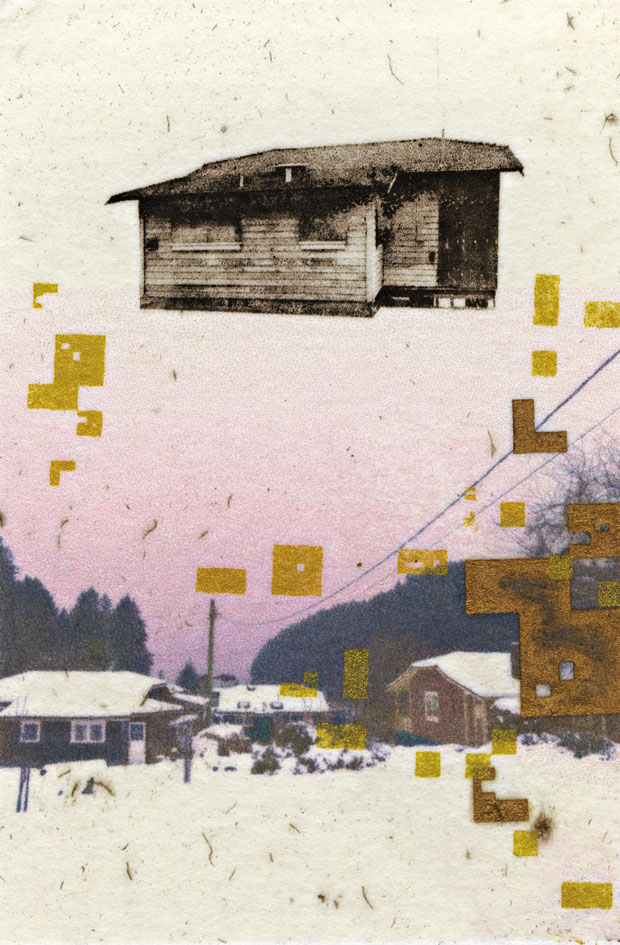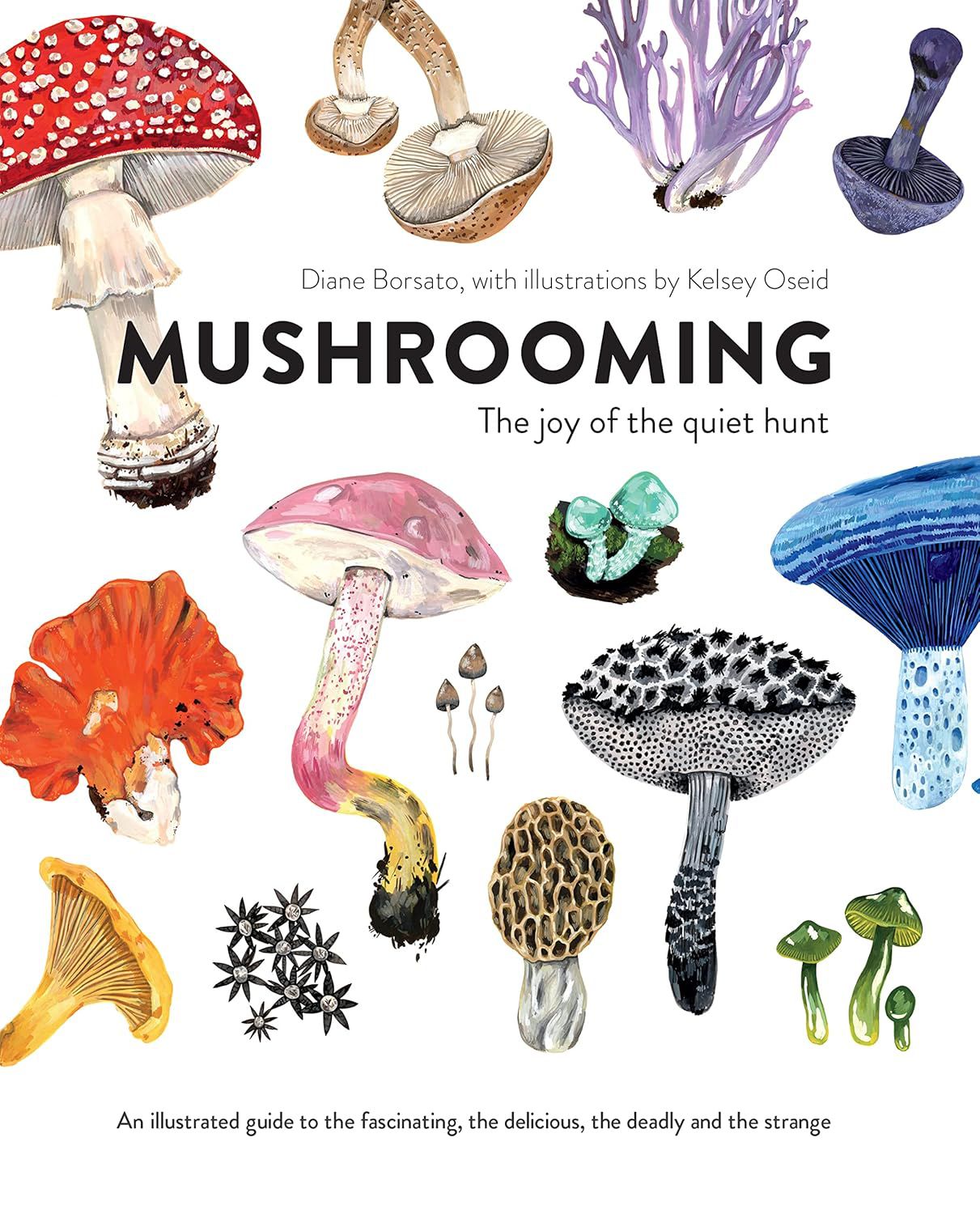

Painting by Maggie Putnum
In 1989, when Harold and Barbara Morgan opened the Museum of Exotic World in the front rooms of Harold’s commercial painting business in Vancouver, they had been travelling the world every winter for forty-five years and had accumulated many souvenirs from the hundred destinations listed on decorative signs in the museum, such as one near the door reading: “New Guinea, Borneo, Africa, Thailand, South America, archeological sites, Machu Picchu Peru, pagan Burma, the Nile Egypt, Abu Simbel.” The Morgans lived above the museum, which was housed in a modest storefront framed by shrubs and wrought-iron railings in the 3100 block of Main Street, a quiet stretch occupied by makeshift shops and offices hunkered down out of range of developers and land speculators. The museum was their retirement project, and it was their intention to open to the public free of charge, every day from nine to eleven in the morning and one to five in the afternoon, as stated forthrightly on signs placed in the front window among a display of framed photographs of dark-skinned people in feather costumes and painted faces that looked as if they had been clipped from the pages of National Geographic:
FREE: NO ADMISSION OR DONATIONSCANNIBAL TRIBES, BURMA PAGODASCOVERED IN GOLD AND JEWELS,TROPICAL INSECTS AND BUTTERFLIES,ANCIENT RUINS, STRANGEUNKNOWN TRIBESMEN.ADULTS ONLY PLEASESPRAY YOUR OWN CAR AT HOME — WEGIVE YOU A FREE LESSON
The window display was the full extent of advertising for the Museum of Exotic World, an establishment content to make itself known to passersby on the near side of the street. I had been living on the other side of the street for some weeks before crossing over and noticing the messages in the window, which I studied closely for some minutes before continuing on my way. The front door to the museum was set into a recess and up a step or two and it was always closed: merely to approach it one had to make a commitment. One day I stepped up to the door and opened it.
THIS IS A MUSEUM OF STRANGE FACTS,AND EXOTIC PLACESMUSEUM ENTRANCE — EXOTIC WORLDCOME IN → → →EGYPT, BURMA, NEW GUINEA, INSECTS,INSECT PEOPLE, MARRAKESH,GUATEMALA, AFRICA
The air in the Museum of Exotic World was suffused with warm light and it was dead quiet in the tiny front room, the walls of which were hidden behind rows of framed photographs and more handmade signs. The effect was instantly claustrophobic: beyond were more small rooms containing trees, plants on the floor, an aquarium, stone urns, spears on the walls, shields, bows, arrows, carved wooden masks and bowls, a stuffed alligator and hundreds of photographs in frames lining the walls from floor to ceiling, and the ceiling too was covered with artifacts (and another stuffed alligator, upside down). A wall panel in the back held butterflies and moths as big as Frisbees. It was impossible in those first moments to achieve any kind of focus: every inch of space seemed to be calling out for attention. Maps, postcards, wreaths, sea shells, more wooden masks: on one of them, beautifully carved, a label that said: “placed in native’s hut to protect from evil spirits.” I recall a walking stick, a wooden cane hung on a wall or a doorknob, and a label next to it: “This cane was a gift from famed San Francisco artist David Joseph.” In a glass case nearby, a few pieces of white coral lay on a dark cloth. The label said: “In a million years or so this coral could produce a white sand beach—note sand forming below!” I looked again at the coral and noted the few grains of white sand that had indeed “formed below.” Among an intimidating display of desiccated insects lay one resembling a dried twig about six inches long. “This is the Walking Stick insect,” read the label. “Extra legs are on the back wall.” Another twig-like creature was identified as “a Flying Leaf Insect—note leaf covering his head”; an unnamed creature eight inches long and covered in spines remained unabashably unnamed: “Your guess is as good as mine,” read the label. I moved gingerly through the agglomeration of things and images and came to a red button protruding from the wall: “Push button to hear fighting baboons.” I pushed the button and a ghastly shriek burst from the wall; more shrieking followed. At this moment an older man in chinos and a light cotton shirt slipped in from somewhere at the back of the premises. “Welcome to our museum,” he said. “Ask if you have any questions.” The potential question was a recurring motif in the museum: a sign on the wall next to a photograph of group of naked men covered in dry white mud and labelled “Mud Men of the Asaro Valley” said the same thing: “Ask questions if you wish.”
After several visits to the Museum of Exotic World I began to gather a fragmentary sense of the world of Harold and Barbara Morgan. I rarely asked the questions encouraged by the notes on the walls: “Piranha Feast! Skeleton of Cow in Amazon River—Ask if you wish,” for example, or: “Heads of enemies, black and shrunken to the size of an orange—Ask for story if you wish.” Among the myriad messages on the walls of Exotic World there was only one caveat, which I was careful to honour:
PLEASE FEEL FREE TO TALK TRAVELBUT NOT POLITICS OR RELIGION.
—so instead of questioning Harold, I marvelled at his evident, almost Edenic thrill in naming the world collected and created by him and his wife, for it soon became apparent that the labour of naming the collection equalled or even surpassed the labour of the collecting; many of the photographs of “unknown tribesmen” were indeed clipped from National Geographic (the Morgans had visited all of the sites in the photographs and some of the photographs on the walls were their own), but the labels were Harold’s alone:
HARD TO BELIEVE: The supporting posts of the haus Tambarani spirit house must rest on the blooded skull of their enemies.
WIGMAN OF THE HULI TRIBE IN NEW GUINEA—their wigs are made of their own hair!
THE SUIBAI: the wife of a deceased husband must wear his severed foot around her neck for a considerable period of time.
The Museum often seemed to emanate as a hallucination of the pages of National Geographic and Life magazine as I recalled them from my childhood in the fifties—a world of the distant, the exotic, the hard-to-believe: we are held in a state of wonder persisting outside of time and place, preserved and labelled so that we know how to perceive it, how to preserve the exotic. Affixed to a photograph of an elderly man were two labels, one a caption: “Grizzled man, face painted blue and red,” and the other an instruction: “Note grizzled appearance.” Facts hard to believe, instructions for marvelling: such are the contents of our cultural unconscious: we are made uneasy by its emanation, as we are made uneasy by the emanations of Disneyland. I was always uneasy in the Museum of Exotic World, to which I returned again and again.
NOTE THAT RAMESES' HEADS ARE CUT OFF BY CAESAR'S MEN!—Thebes, Egypt
WOMEN OF THE ZULU TRIBE have defied the missionaries' rule that they must cover their upper bodies.
Brute and fierce, the Huli killed all their enemies and burned their villages—QUESTIONS?
The Morgans were determined to share their exotic world with the nearby world of their own neighbourhood. But when we allow the exotic (which is by definition the distant) to determine what we see, we cannot see what is near; the nearby is historical, and there is no history in the Exotic—no land claims, no land developers, no struggle. The exotic is limited always to collections, even personal ones. I visited the Museum of Exotic World for the last time in 1999. The sign advertising the Spray Your Own Car service was no longer in the window; Harold was very ill and bedridden; and Barbara, whom I met that day for the first time, could make herself available only on weekends for the questions that I never asked. She was stooped and used a cane, and she treated me kindly (she was accustomed to people with notebooks). I presumed that the museum was nearing the end of its term. And then last month I discovered that the Museum of Exotic World had been rescued and preserved by an antiques dealer named Alexander Lamb of 3271 Main Street; and from Alexander Lamb I learned that when Harold died, Barbara had put the museum up for auction and he had acquired it in accordance with her wish that it not be broken up. It was now reassembled in the back of Mr. Lamb’s store, and I passed an afternoon browsing again through the annotated memories of the Morgans, and found labels that I did not remember seeing before: “Arrived day before plot to kill the dictator Trujillo. Even we were under suspicion.—Ask for story if interested.” “Hard to believe: lost in the jungle of New Guinea are believed to be 900 planes lost in the Pacific War!” The only new additions to the collection are two small boxes adorned with carved Asian dog-lions and placed on a high shelf: contained within them at their request are the ashes of Harold and Barbara Morgan, proprietors of the Museum of Exotic World.








